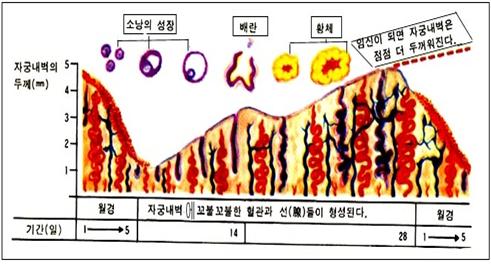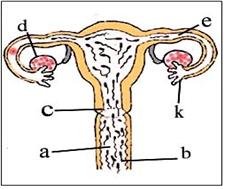월경, 배란, 월경주기, Menstruration, Ovulation, Menstruation phase
| 월경과 배란 |
Menstruation and Ovulation
- 남녀의 뇌 속에 한 개의 뇌하수체선이 있다. 여성 골반 강 속에 두 개의 난소가 정상적으로 있다. 난소 속에 있는 난포와 황체, 자궁 등에서 분비되는 에스트로겐(Estrogen), 난소 속에 있는 황체 등에서 분비되는 프로게스테론(Progesterone)과 뇌하수체에서 분비되는 난포 자극 호르몬(FSH), 황체 형성 호르몬(LH) 등 여러 종류의 호르몬들의 영향을 받아 난소와 자궁이 상호반응 작용해 주기적으로 월경을 하게 된다.
- 이와 같이, 월경은 자궁에서 나오는 단순한 출혈이 아니고, 하루아침에 갑자기 시작되는 출혈이 아니다.
- 예를 들면, 월경 주기에 따라 월경 출혈이 시작하기 약 28일 전부터 뇌하수체, 난소와 자궁 등이 조화롭게 상호작용해 주기적으로 월경을 하는 것이다.
| 월경 주기와 배란 |

그림 1-47.월경 주기와 배란
출처-Carnation Company, Illustrations from Pregnancy in Anatomical과 소아가정간호백과
- 월경 출혈(Menstruation bleeding)은 3~7일간 계속되는 것이 보통이다.
- 월령 주기에 월경출혈을 며칠 간 한 후 바로, 거의 같은 방법으로 다음 월경 주기에 할 수 있는 월경 출혈 준비를 바로 하기 시작한다.
- 월경 주기(Menstruation phase)는 평균 28일이다.
- 월경 주기 동안에 임신이 성립되지 않거나, 어떤 건강 문제가 생기지 않는 한, 사춘기 여아들과 성인 여성들은 폐경기가 올 때까지 월경 출혈을 일정한 월경 주기를 두고 매 월경 주기에 며칠 동안 하게 된다.
- 초경을 한 이후 몇 개월 내지 몇 년 동안 지나면, 대부분의 사춘기 여아들과 여성들은 약 28일을 한 월경 주기로, 즉 약 28일 간격을 두고, 월경 출혈을 몇 일간 할 수 있다.
- 여성의 월경 축은 자궁, 난소, 뇌하수체 등으로 이루어진다.
- 한 여성에게 월경주기가 정상적으로 규칙적으로 계속되는 것은 월경 축에 있는 각 기관의 기능이 정상이라는 것을 간접적으로 알려준다.
- 초경을 한 이후 얼마 후 뇌하수체의 난포 자극 호르몬으로 난포가 자극받아 난포에서 한 달에 한 개의 난자가 배란된다.
- 난포에서 에스트로겐과 프로게스테론이란 여성 호르몬이 적절히 분비된다.
- 에스트로겐은 수정된 수정란이 자궁 내벽에 착상될 수 있도록 자궁 내벽을 적절히 만드는 작용을 한다.
- 월경 주기의 중간 날 한 개의 난자가 난포에서 나팔관 속으로 배란된다.
- 난자가 배란된 난포는 황체가 되고 그 황체에서 프로게스테론이 분비된다.
- 난포 프로게스테론은 태반 프로게스테론과 함께 자궁 내벽에 착상된 수정란이 계속 자라서 태아가 되고 그 태아가 계속 자랄 수 있게 돕는 역할을 한다.
- 난자가 정자를 만나 수정이 성립되지 않으면 임신이 성립되지 않는다. 그리고 자궁 내벽은 다음 월경 출혈을 시작하기 직전까지 점점 최대한도 얇아진다.
- 결국에는 자궁 내벽에 있는 혈관이 터지고 자궁내벽에서 출혈된다.
- 이런 생리적 출혈을 월경, 월경 출혈, 생리출혈, 또는 생리라고 한다.

그림1-48. 여성 내부 생식기. 질강 속에 1회 사정된 3-5억 개의 정자가 난자를 찾아 난관 속으로 이동한다.
a-정자, b-질, c-자궁경부, d-난소, e-난관, k-나팔관
Copyright ⓒ 2012 John Sangwon Lee, MD., FAAP

그림 1-49. 여성 내부 생식기. 한 개의 난자가 한 개의 정자를 만나 한 개의 수정란이 된다. 그 수정란이 자궁내벽에 착상하기 위해 난관을 거쳐 자궁 속으로 이동한다. a-난소, b-수정란, c-자궁 강
Copyright ⓒ 2012 John Sangwon Lee, MD., FAAP
Menstruation, Ovulation, Menstruation phase
Menstruation and Ovulation
• There is one pituitary gland in the brains of men and women. There are normally two ovaries in the female pelvic cavity. Various hormones such as estrogen secreted from the follicle, corpus luteum, and uterus in the ovary, progesterone secreted from the corpus luteum, and follicle-stimulating hormone (FSH) and luteinizing hormone (LH) secreted from the pituitary gland under the influence of these, the ovaries and the uterus interact and menstruate periodically.
• As such, menstruation is not just bleeding from the uterus, nor bleeding that starts overnight.
• For example, according to the menstrual cycle, the pituitary gland, ovary, and uterus interact harmoniously about 28 days before the onset of menstrual bleeding to periodically menstruate.
Menstrual cycle and ovulation

Figure 1-47. Menstrual cycle and ovulation. Source-Carnation Company, Illustrations from Pregnancy in Anatomical and Encyclopedia of Pediatric and Family Nursing
• Menstruation bleeding usually lasts 3 to 7 days.
• Immediately after a few days of menstrual bleeding in your menstrual cycle, start preparing for your next menstrual cycle in much the same way.
• Menstruation phase averages 28 days.
• Adolescent girls and adult women will have regular menstrual bleeding for several days in each menstrual cycle until menopause unless the pregnancy is established or any health problems arise during the menstrual cycle.
• Months to years after menarche, most adolescent girls and women can bleed for several days in a menstrual cycle of about 28 days, ie about 28 days apart.
• A woman’s menstrual axis consists of the uterus, ovaries, and pituitary gland.
• For a woman, the normal and regular continuation of the menstrual cycle indirectly indicates that each organ on the menstrual axis is functioning normally.
• Shortly after menstruation, the follicle is stimulated by a follicle-stimulating hormone from the pituitary gland, and one egg per month is ovulated from the follicle.
• The female hormones estrogen and progesterone are properly secreted from the follicle.
• Estrogen works by making the lining of the uterus suitable for implantation of a fertilized egg on the lining of the uterus.
• On the middle day of the menstrual cycle, one egg is ovulated from the follicle into the fallopian tube.
• The follicle that ovulates becomes the corpus luteum and progesterone is secreted from the corpus luteum.
• Follicular progesterone, along with placental progesterone, helps the fertilized egg implanted in the uterine wall continue to grow into a fetus and continue to grow.
• If the egg meets the sperm and fertilization is not established, pregnancy cannot be established. And the lining of the uterus becomes as thin as possible until just before the onset of the next menstrual bleeding.
• Eventually, the blood vessels in the lining of the uterus rupture and bleed from the lining of the uterus.
• This physiological bleeding is called menstruation, menstrual bleeding, menstrual bleeding, or menstruation.

Figure 1-48. Female internal genitalia. Three to five billion sperms ejaculated once in the vaginal cavity move into the fallopian tubes in search of eggs. a – sperm, b – vagina, c – cervix, d – ovaries, e – fallopian tubes, k – fallopian tubes Copyright ⓒ 2012 John Sangwon Lee, MD., FAAP

Figure 1-49. Female internal genitalia. One egg meets one sperm to form one fertilized egg. The fertilized egg travels through the fallopian tubes into the uterus to implant in the uterine lining. a – ovary, b – fertilized egg, c – cavity of the uterus Copyright ⓒ 2012 John Sangwon Lee, MD., FAAP
출처 및 참조문헌
- www.drleepediatrics.com 제1권 소아청소년 응급 의료
- www.drleepediatrics.com 제2권 소아청소년 예방
- www.drleepediatrics.com 제3권 소아청소년 성장 발육 육아
- www.drleepediatrics.com 제4권 모유,모유수유, 이유
- www.drleepediatrics.com 제5권 인공영양, 우유, 이유식, 비타민, 미네랄, 단백질, 탄수화물, 지방
- www.drleepediatrics.com 제6권 신생아 성장 발육 육아 질병
- www.drleepediatrics.com제7권 소아청소년 감염병
- www.drleepediatrics.com제8권 소아청소년 호흡기 질환
- www.drleepediatrics.com제9권 소아청소년 소화기 질환
- www.drleepediatrics.com제10권. 소아청소년 신장 비뇨 생식기 질환
- www.drleepediatrics.com제11권. 소아청소년 심장 혈관계 질환
- www.drleepediatrics.com제12권. 소아청소년 신경 정신 질환, 행동 수면 문제
- www.drleepediatrics.com제13권. 소아청소년 혈액, 림프, 종양 질환
- www.drleepediatrics.com제14권. 소아청소년 내분비, 유전, 염색체, 대사, 희귀병
- www.drleepediatrics.com제15권. 소아청소년 알레르기, 자가 면역질환
- www.drleepediatrics.com제16권. 소아청소년 정형외과 질환
- www.drleepediatrics.com제17권. 소아청소년 피부 질환
- www.drleepediatrics.com제18권. 소아청소년 이비인후(귀 코 인두 후두) 질환
- www.drleepediatrics.com제19권. 소아청소년 안과 (눈)질환
- www.drleepediatrics.com 제 20권 소아청소년 이 (치아)질환
- www.drleepediatrics.com 제21권 소아청소년 가정 학교 간호
- Red book 29th-31st edition 2021
- Nelson Text Book of Pediatrics 19th- 21st Edition
- The Johns Hopkins Hospital, The Harriet Lane Handbook, 22nd edition
- 응급환자관리 정담미디어
-
소아가정간호백과–부모도 반의사가 되어야 한다, 이상원
-
Neonatal Resuscitation American heart Association
-
Neonatology Jeffrey J.Pomerance, C. Joan Richardson
-
Pediatric Resuscitation Pediatric Clinics of North America, Stephen M. Schexnayder, M.D.
-
Pediatric Critical Care, Pediatric Clinics of North America, James P. Orlowski, M.D.
-
Preparation for Birth. Beverly Savage and Dianna Smith
-
Infectious disease of children, Saul Krugman, Samuel L Katz, Ann A. Gershon, Catherine Wilfert
- 소아과학 대한교과서
- Other
Copyright ⓒ 2015 John Sangwon Lee, MD., FAAP
“부모도 반의사가 되어야 한다”-내용은 여러분들의 의사로부터 얻은 정보와 진료를 대신할 수 없습니다.
“The information contained in this publication should not be used as a substitute for the medical care and advice of your doctor. There may be variations in treatment that your doctor may recommend based on individual facts and circumstances. “Parental education is the best medicine.”